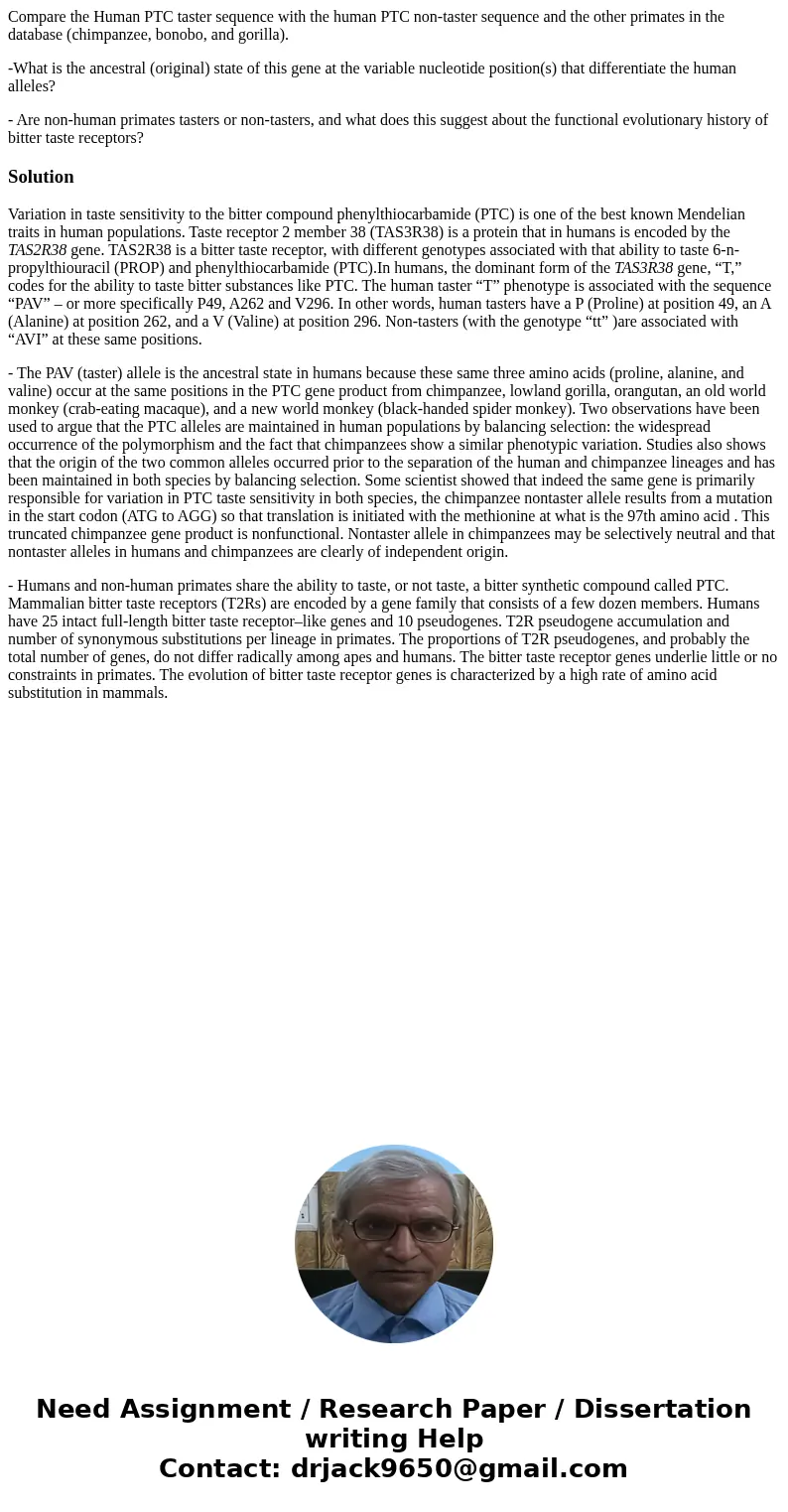Compare the Human PTC taster sequence with the human PTC non
Compare the Human PTC taster sequence with the human PTC non-taster sequence and the other primates in the database (chimpanzee, bonobo, and gorilla).
-What is the ancestral (original) state of this gene at the variable nucleotide position(s) that differentiate the human alleles?
- Are non-human primates tasters or non-tasters, and what does this suggest about the functional evolutionary history of bitter taste receptors?
Solution
Variation in taste sensitivity to the bitter compound phenylthiocarbamide (PTC) is one of the best known Mendelian traits in human populations. Taste receptor 2 member 38 (TAS3R38) is a protein that in humans is encoded by the TAS2R38 gene. TAS2R38 is a bitter taste receptor, with different genotypes associated with that ability to taste 6-n-propylthiouracil (PROP) and phenylthiocarbamide (PTC).In humans, the dominant form of the TAS3R38 gene, “T,” codes for the ability to taste bitter substances like PTC. The human taster “T” phenotype is associated with the sequence “PAV” – or more specifically P49, A262 and V296. In other words, human tasters have a P (Proline) at position 49, an A (Alanine) at position 262, and a V (Valine) at position 296. Non-tasters (with the genotype “tt” )are associated with “AVI” at these same positions.
- The PAV (taster) allele is the ancestral state in humans because these same three amino acids (proline, alanine, and valine) occur at the same positions in the PTC gene product from chimpanzee, lowland gorilla, orangutan, an old world monkey (crab-eating macaque), and a new world monkey (black-handed spider monkey). Two observations have been used to argue that the PTC alleles are maintained in human populations by balancing selection: the widespread occurrence of the polymorphism and the fact that chimpanzees show a similar phenotypic variation. Studies also shows that the origin of the two common alleles occurred prior to the separation of the human and chimpanzee lineages and has been maintained in both species by balancing selection. Some scientist showed that indeed the same gene is primarily responsible for variation in PTC taste sensitivity in both species, the chimpanzee nontaster allele results from a mutation in the start codon (ATG to AGG) so that translation is initiated with the methionine at what is the 97th amino acid . This truncated chimpanzee gene product is nonfunctional. Nontaster allele in chimpanzees may be selectively neutral and that nontaster alleles in humans and chimpanzees are clearly of independent origin.
- Humans and non-human primates share the ability to taste, or not taste, a bitter synthetic compound called PTC. Mammalian bitter taste receptors (T2Rs) are encoded by a gene family that consists of a few dozen members. Humans have 25 intact full-length bitter taste receptor–like genes and 10 pseudogenes. T2R pseudogene accumulation and number of synonymous substitutions per lineage in primates. The proportions of T2R pseudogenes, and probably the total number of genes, do not differ radically among apes and humans. The bitter taste receptor genes underlie little or no constraints in primates. The evolution of bitter taste receptor genes is characterized by a high rate of amino acid substitution in mammals.

 Homework Sourse
Homework Sourse